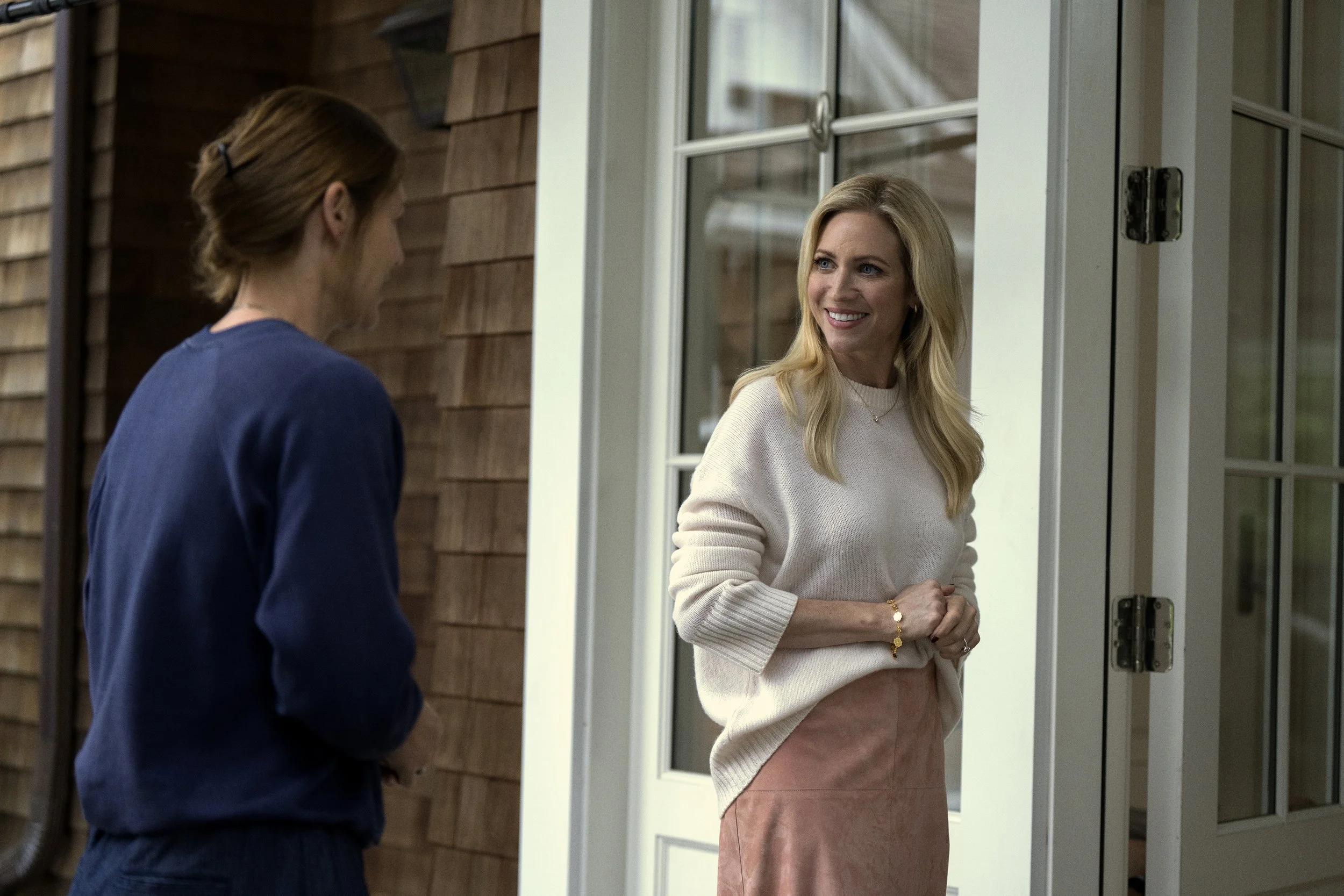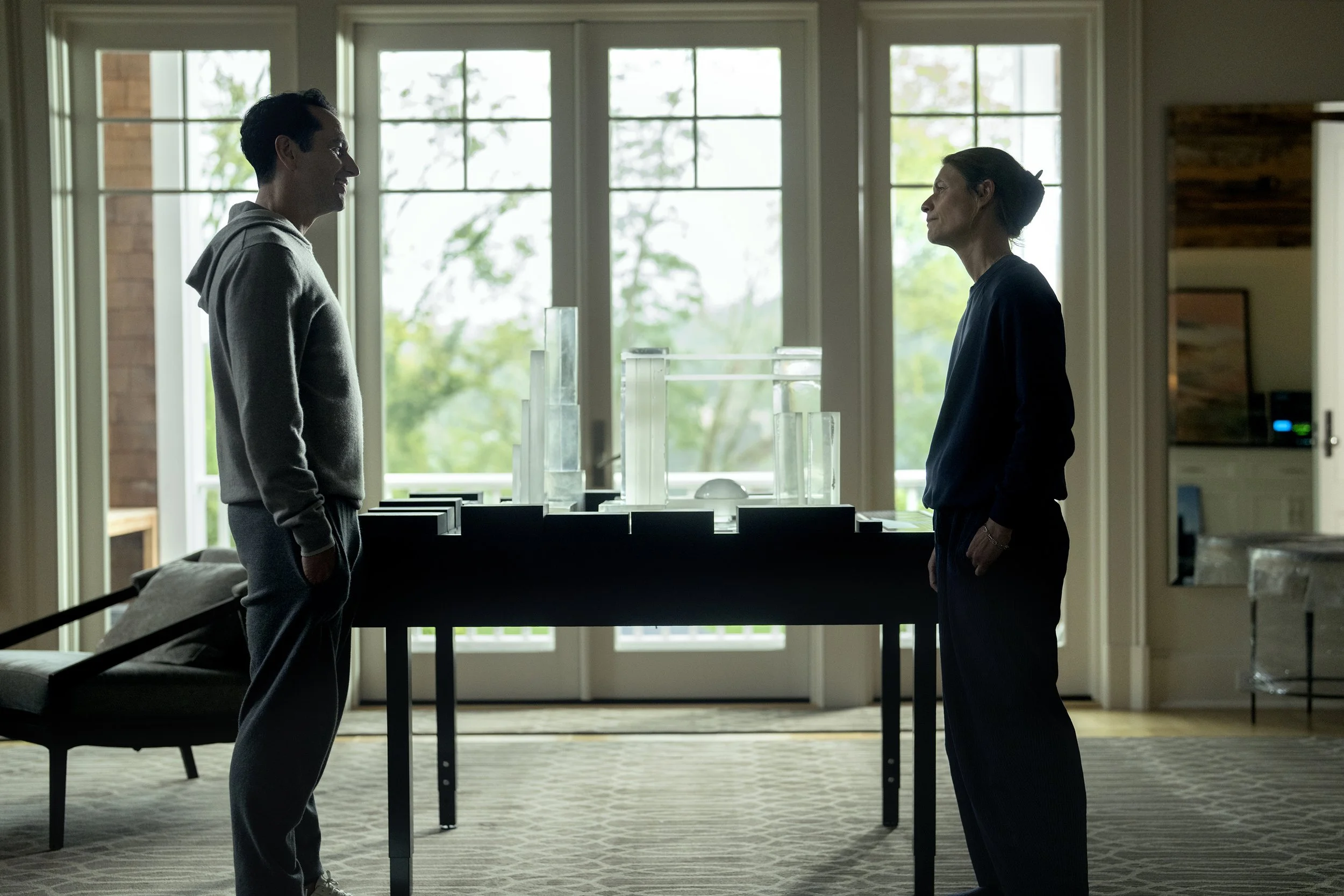‘The Beast in Me’ Review: Netflix Returns to Prestige Thrillers With a Sharp, Slow-Burn Cat-and-Mouse Showcase for Claire Danes and Matthew Rhys
Claire Danes as Aggie Wiggs in Episode 101 of The Beast in Me. Cr. Courtesy of Netflix © 2025
A gripping, slow-burn psychological thriller with outstanding performances from Claire Danes and Matthew Rhys, The Beast in Me delivers the kind of tension, character work, and emotional stakes that Netflix has been chasing for years.
For the last few years, Netflix has been chasing its own version of “prestige thriller” — the kind of adult, character-driven drama that once defined Sunday nights on cable. You could feel the algorithm trying to brute-force its way there: star-studded miniseries, loosely political mysteries, suburban crime sagas that promised depth but always seemed to flatten out by episode four. The Beast in Me is the rare series that actually breaks that pattern. It’s not just another glossy murder story with a tasteful title font. It feels like a true throwback to the era when thrillers trusted their audience to be patient, pay attention, and live in discomfort.
At the center of it all is Claire Danes, doing what Claire Danes does better than almost anyone: playing a woman under pressure who refuses to collapse into easy archetypes. Her character, Aggie Wiggs, could have been a cable-drama cliché — the haunted writer, the grieving mother, the woman spiraling alone in a big house with too much history and not enough light. Instead, Danes shades her with a mix of intelligence, stubbornness, and emotional volatility that makes Aggie feel less like a construct and more like someone whose life you’ve wandered into at a very specific, precarious moment.
Aggie is not a detective by trade. She’s a writer, someone who has spent her career dissecting other people’s lives on the page. That’s an important distinction. Her instincts are more emotional than procedural; she doesn’t hunt clues so much as human tells. And The Beast in Me is smart enough to let that guide the storytelling. The tension doesn’t come from elaborate puzzles or contrived “gotcha” reveals — it comes from the unease of watching Aggie follow her own curiosity into places that might be dangerous, ill-advised, or quietly self-destructive.
Matthew Rhys as Nile Jarvis in Episode 102 of The Beast in Me. Cr. Courtesy of Netflix © 2025
Opposite her is Matthew Rhys as Nile Jarvis, the man at the center of a local storm that may or may not be justified. He’s wealthy, insulated, and rumored to have done something terrible, the kind of man whose reputation arrives long before he does. In lesser hands, Nile would be either an obvious monster or an obvious red herring. Rhys walks a much narrower line. He plays Nile with a deliberate ambiguity that never feels like a gimmick — he’s disarming one scene, unnerving the next, and you believe both versions could be true. The show understands that real danger doesn’t always look wild or unhinged. Sometimes it looks like someone who knows exactly how he’s being perceived and has learned to use that perception as a shield.
What makes The Beast in Me so effective is that it refuses to spoon-feed your feelings about either character. Aggie is not “likable” in the way algorithms often demand. She can be prickly, obsessive, abrasive, even reckless. But because the series is so tightly tethered to her perspective, you’re forced to sit with her contradictions. Her grief doesn’t make her saintly; it makes her sharper, more defensive, harder to read. Danes has always excelled at playing women who don’t tidy themselves up for the camera, and Aggie gives her plenty of space to lean into that again. Just like in the best Homelandseasons, the thrill is as much about watching her think as watching her act.
Structurally, the series leans into that subjectivity. It doesn’t rush to tell you exactly what happened in the past or who’s lying in the present. Instead, it lets information arrive sideways: in offhand comments, in half-finished sentences, in the way people react to Aggie’s presence. That deliberate pacing will frustrate anyone looking for a twist every ten minutes, but that isn’t the show’s aim. The Beast in Me works because it’s comfortable living in uncertainty. The question isn’t just “Did Nile do it?” — it’s “Why is Aggie drawn to this man, and what is she really looking for in his story?”
There’s a quiet, cumulative power to that approach. The more time you spend in Aggie’s world — inside her creaking house, on her lonely walks, across the street from Nile’s curated life — the more you start to notice how much of the tension here is environmental. The setting isn’t just background; it’s pressure. The wealthy Long Island enclave feels both expansive and claustrophobic, the kind of place where everyone has space, but no one has privacy. The show leans into that duality: wide, airy exteriors that immediately fold into tight, closed-off interiors; open roads that somehow feel like corridors.
(L to R) Matthew Rhys as Nile Jarvis and Claire Danes as Aggie Wiggs in Episode 103 of The Beast in Me. Cr. Chris Saunders/Netflix © 2024
Visually, the series has a hushed, coastal melancholy. The color palette favors grays, greens, and soft blues, with splashes of warmth that never quite feel safe. The camera often hangs back just a beat longer than you expect — watching Aggie from a distance as she watches someone else, or holding on a doorway after a character exits, as if daring something unseen to finally step through. It’s the kind of filmmaking that doesn’t need jump scares to unnerve you. It just needs time.
That’s where The Beast in Me most clearly channels that “old days of Homeland” feeling: not in espionage or politics, but in its trust that tension can be built from mood, psychology, and character dynamics rather than constant escalation. The show lets scenes breathe. Conversations take longer than they “need” to. Pauses are allowed to hang. You’re always waiting for someone to slip, confess, or lash out, and that wait becomes its own form of suspense.
(L to R) Claire Danes as Aggie Wiggs and Brittany Snow as Nina in Episode 102 of The Beast in Me. Cr. Chris Saunders/Netflix © 2024
The supporting cast adds crucial texture. Brittany Snow brings a disarming openness to a character who could have easily been sidelined or flattened into a type. Natalie Morales adds emotional weight and lived-in history to Aggie’s past, reminding you that this story began long before Nile ever showed up. And Jonathan Banks, unsurprisingly, is a presence the second he appears. He doesn’t need big speeches or theatrics; his authority and weariness do most of the work for him. Every time he enters a scene, the power balance shifts slightly, and the show knows it.
One of the most satisfying choices the series makes is that it doesn’t confuse “dark” with “shocking.” It’s mature without being gratuitous. Dark things happen, and dark impulses are explored, but the show is more interested in what violence does to people than in the violence itself. It’s about how suspicion corrodes relationships, how grief distorts judgment, and how easily narratives can be rewritten when enough money and influence are involved. That thematic focus helps the series feel cohesive even when the plot takes quieter, more interior detours.
Claire Danes as Aggie Wiggs in Episode 102 of The Beast in Me. Cr. Courtesy of Netflix © 2025
Thematically, The Beast in Me lives in that familiar but fertile territory where true crime, voyeurism, and morality intersect. Aggie doesn’t simply want to know what happened; she wants to decide what to do with what she learns. That gives the show an interesting ethical undercurrent. Is she exposing the truth? Exploiting it? Hiding inside it? The series doesn’t resolve that cleanly, and it’s stronger for it. It understands that people are often driven by multiple motives at once: guilt, curiosity, ambition, self-preservation. Aggie embodies all of that, and Danes makes those contradictions feel human rather than “conceptual.”
On the genre front, The Beast in Me is more psychological thriller than whodunit. It isn’t interested in building an elaborate puzzle box only to pop it open in the final minutes. It wants you to live inside the uncomfortable process of not knowing — of suspecting, doubting, rethinking, and re-feeling as new information arrives. That’s a far more interesting, and frankly more adult, form of suspense than the usual twist-of-the-week rhythm that defines so many streaming dramas.
What also helps is that the show doesn’t feel desperate to be “prestige.” It’s stylish, but not self-conscious. There’s no relentless needle-drop strategy trying to convince you how you should feel. The score is restrained, nudging without overpowering. The dialogue feels natural, even when the characters are dancing around big emotional truths. And the series isn’t constantly elbowing you with timely references or overwritten monologues about “what this all means.” It trusts its imagery, its actors, and the situation to carry the weight.
(L to R) Matthew Rhys as Nile Jarvis and Claire Danes as Aggie Wiggs in Episode 103 of The Beast in Me. Cr. Courtesy of Netflix © 2025
And then there’s the simple, old-fashioned pleasure of watching two great actors share the frame and test each other. The conversations between Danes and Rhys are where the show really sings. They’re not grandstanding; they’re probing. You can feel both characters clocking each other, testing boundaries, changing tactics mid-sentence. Sometimes they’re adversaries, sometimes uneasy collaborators, sometimes something murkier. That shifting dynamic is the engine of the show, and the writing wisely keeps returning to it.
POPULAR ON THE CINEMA GROUP
For a Netflix thriller, The Beast in Me also shows impressive restraint with its pacing across the eight episodes. There’s no saggy middle stretch where the show starts spinning its wheels just to get to a pre-ordained finale. Instead, it moves like a long uphill climb — steady, deliberate, occasionally pausing to look down and remind you how far you’ve already come. By the time you reach the final episodes, the momentum is emotional as much as narrative. You don’t just want answers; you want to know what those answers will do to Aggie.
If there’s any minor critique to lodge, it’s that some viewers will come in expecting a flashier, twistier ride than the show is interested in offering. This isn’t a series built around one big rug-pull. It’s more interested in erosion than explosion. That’s not a flaw so much as a choice, and it’s a welcome one. We’ve had plenty of thrillers engineered to be bingeable in the most disposable sense — the ones you devour in a weekend and forget by Tuesday. The Beast in Me feels built to linger.
(L to R) Matthew Rhys as Nile Jarvis and Claire Danes as Aggie Wiggs in Episode 103 of The Beast in Me. Cr. Courtesy of Netflix © 2025
Ultimately, what makes the series stand out is how fully it commits to its central idea: that the scariest stories aren’t always about masked killers or elaborate conspiracies. Sometimes they’re about the stories we tell ourselves to survive, the people we choose to believe, and the versions of ourselves we become when we’re backed into a corner. In that sense, the “beast” of the title isn’t a monster lurking in the shadows. It’s the capacity for damage and deception that lives quietly inside everyone — and what happens when circumstances invite it out.
For Netflix, this is the closest thing they’ve had in years to an old-school, watercooler thriller — the kind of show that feels designed for adults who miss the days when Sunday night dramas weren’t afraid to be slow, subtle, and emotionally messy. For Claire Danes and Matthew Rhys, it’s a reminder of how rare it is to see two actors of their caliber given this much space to play in a genre that often treats characters as devices. And for audiences exhausted by thin, twist-obsessed mystery series, The Beast in Me is a welcome return to something richer, stranger, and far more satisfying.
If you wanted it thrilling, emotionally engaging, and reminiscent of prestige tv’s true heyday, that’s exactly what this feels like.
RAting: ★★★★½
That's A Wrap
|
The Beast in Me
|
That's A Wrap | The Beast in Me |
“A tense, beautifully acted psychological thriller that feels like a throwback to the prestige TV heyday. Claire Danes and Matthew Rhys are phenomenal together, turning every conversation into a power play. Slow-burn, character-first, and quietly devastating — Netflix finally feels like Netflix again.”
CREDITS
Release Date: Thursday, November 13 | Netflix
Cast: Claire Danes, Matthew Rhys, Brittany Snow, Natalie Morales, Jonathan Banks
Creator: Gabe Rotter
Directors: Antonio Campos and others
Rating: TV-MA
Out Now: Streaming on Netflix





























